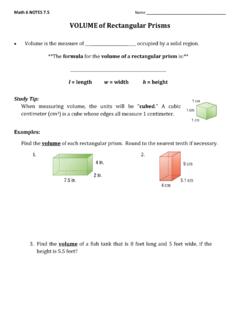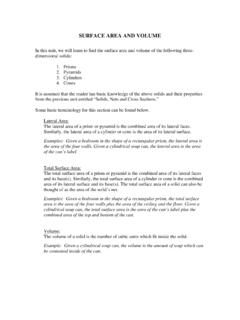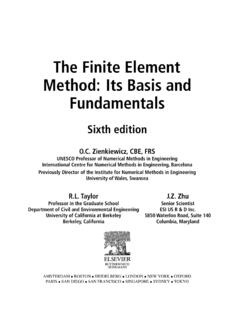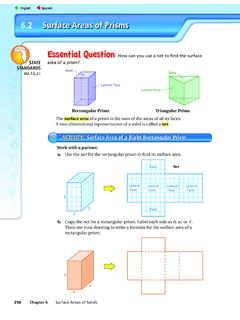Transcription of Unit 6 Visualising Solid Shapes(final)
1 3D shapes/objects are those which do not lie completely in aplane. 3D objects have different views from different positions. A Solid is a polyhedron if it is made up of only polygonal faces, thefaces meet at edges which are line segments and the edges meet ata point called vertex. Euler s formula for any polyhedron is,F + V E = 2 Where F stands for number of faces, V for number of vertices andE for number of edges. Types of polyhedrons:(a)Convex polyhedronA convex polyhedron is one in which all faces make it (1)(2)(3)(4)12/04/18 (1) and (2) are convex polyhedrons whereas(3) and (4) are non convex polyhedron.(b)Regular polyhedra or platonic solids:A polyhedron is regular if its faces are congruent regularpolygons and the same number of faces meet at each example, a cube is a platonic Solid because all six of itsfaces are congruent squares. There are five such solids tetrahedron, cube, octahedron, dodecahedron and A prism is a polyhedron whose bottom and top faces (known asbases) are congruent polygons and faces known as lateral facesare parallelograms (when the side faces are rectangles, the shapeis known as right prism ).
2 A pyramid is a polyhedron whose base is a polygon and lateralfaces are triangles. A map depicts the location of a particular object/place in relationto other objects/places. The front, top and side of a figure are shown. Use centimetre cubes tobuild the figure. Then sketch the views below represent a three-dimensional figure that cannot bebuilt from cubes. Determine which three-dimensional figures matchthe TopSideFrontTopSideFrontTopSide12/04/18 In examples 1 and 2, write the correct answer from the given 1:A prism is a polyhedron whose lateral faces are(a)Circles(b)Triangles(c)Parallelogra ms(d)Rhombuses or RhombiSolution:Correct answer is (c).Example 2:A pyramid is a polyhedron whose lateral faces are(a)Rectangles(b)Triangles(c)Parallelo grams(d)Rhombuses or RhombiSolution:Correct answer is (b).In examples 3 and 4, fill in the blanks to make the statements trueExample 3:In a regular polyhedron _____ numberof faces meet at each 4:A pentagonal prism has _____ examples 5 and 6, state whether the statements aretrue or 5:A sphere is a :False.
3 Scale is the relationship between the drawing s/model sdimensions to the actual object s dimensions. In a map, symbols are used to depict the different objects and places. Maps involve a scale which is fixed for a particular map. Explain how you would find the surface area of an open-top box that isshaped like a rectangular prism . Describe the shapes in a net used to cover a Example 6:In a prism the lateral faces need not be 7:Draw the top, front and side views of the given :Front viewTop viewSide view Use a compass and straight edge to create a larger version of each neton a cardboard. Fold each net into a POLYHEDRONS NAMEFACESEXAMPLENETT etrahedron4 trianglesOctahedron8 trianglesIcosahedron20 trianglesCube6 squaresDodecahedron12 pentagons12/04/18 Example 8:Use isometric dot paper to sketch a rectangular prismwith length 4 units, height 2 units and width 3 :Steps:(1)Draw a parallelogramwith sides 4 units and3 is top of the prism (Fig 1).
4 (2)Start at one a line passingthrough two for other threevertices. Draw thehidden edges asdashed line (Fig 2).(3)Connect the ends ofthe lines to completethe prism (Fig 3). the table forthe number of verticesV, edges E and faces Ffor each of thepolyhedrons you a ConjectureWhat do you think istrue about therelationship betweenthe number of vertices,edges and faces of apolyhedron?POLYHEDRONVEFV - E + FTetrahedronOctahedronIcosahedronCubeDod ecahedronWidthLength 2 Fig. 312/04/18 Example 9:Identify the shape whose net is given :This shape is entirely made of equilateral triangles. Whenfolded, it results in a regular octahedron. Note that sincethese are all equilateral and congruent faces, it is aregular 10:The Solid given below is a rectangular prism or all the diagonals of this :There are only four diagonals as shown below. A polyhedron is formed by four or more polygons that intersect only at theiredges.
5 The faces of a regular polyhedron are all congruent regular polygonsand the same number of faces intersect at each vertex, Regular polyhedronsare also called Platonic Solid . There are exactly five regular Example 11:Count the number of cubes in the given :(i) 8 cubes(ii) 6 cubesExample 12 :Name the following polyhedrons and verify the Euler sformula for each of them.(a)(b)(c)Solution:S. NoPolyhedronFVF + VEF + V E(a)Tetrahedron44862(b)Cube6814122(c)Pen tagonal71017152prismVolume, the space inside a three-dimensional object, is measured in cubicunit. If the blocks you build are each 1 cubic unit , then the volume of ablock structure is equal to the number of blocks in the structure. For example,a structure made from eight blocks has a volume of 8 cubic units. If theblocks have an edge length of 1 cm, the structure s volume is 8 that in a 3D shape, diagonals connect two verticesthat do not lie on the same the line segment from A to H in figure below is nota diagonal for the Solid .
6 Diagonals must pass throughthe inside of the shape. However, AH is diagonal of Example 13:A polyhedron has 7 faces and 10 vertices. How manyedges does the polyhedron have?Solution:For any polyhedron,F + V E = 2 Here, F = 7, V = 10, E = ?Using above formula, 7 + 10 E = 2 17 E = 2 17 2 = E = 15 Example 14:Find the number of vertices in a polyhedron which has30 edges and 12 :For any polyhedron,F + V E = 2 Here, F = 12, V = ?, E = 30 Using above formula,12 + V 30 = 2V 18 = 2V = 2 + 18V = 20 Example 15:The distance between City A and City B on a map isgiven as 6 cm. If the scale represents 1 cm = 200 km,then find the actual distance between City A and City :Actual distance represented by 1cm = 200 kmWhat is the surface area of a single block in square units?If the edge lengths of a block are 2 cm, what is the block s surface area?What is the volume of the structure at the right in cubic units?
7 What is the surface area of the structure above in square units?(Remember: Count only the squares on the outside of the structure.)12/04/18 Actual distance represented by 6 cm = 6 200 km= 1200 kmSo, actual distance between City A and City B is1200 16:Height of a building is 9 m and this building is representedby 9 cm on a map. What is the scale used for the map?Solution:Scale of map = SizedrawnActualsize9cm900cm (because 9 m = 900 cm)1100 Thus, scale is 1 17:The scale on a map is 1 mm : 4 m. Find the distance onthe map for an actual distance of 52 :Distance on map for an actual distance of 4 m = 1 mmDistance on map for actual distance of 52 m1524 = 13 mmThus, distance on map for actual distance of 52 m is13 prisms have two identical, parallel faces. These two faces are alwayspolygons. A prism s other faces are always prism is sometimes referred to by the shape of the two identical faces onits ends.
8 For example, a triangular prism has triangular faces on its ends,and a rectangular prism has rectangular faces on its PrismRectangular PrismExample 18:Application of problemsolving strategyDetermine the number ofedges, vertices and in thefollowing figure:12/04/18 Solution:Understand and Explore the problem What information is given in the question?A cube with one of its corner cut. What are you trying to find?The no. of edges, vertices and faces. Is there any information that is not needed?The measures of edges are not a strategy Think of the definitions of an edge, vertex and facesand try to co-relate them to the figure given The polygonal regions are called faces, hence there are7 faces. The line segment formed by the intersection of two facesis called edges, hence there are 15 edges. Edges meet at vertices which are points, hence thereare 10 The above answer is verified using Euler s + V = E + 2 For the above problem, F = 7, V = 10, E = 15F + V = 7 + 10 = 17E + 2 = 15 + 2 = 17 Hence F + V = E + 2 is figures are figures are not In each of the questions 1 to 21, out of four options only one is the correct amongst the following is not a polyhedron?
9 (a)(b) (c) (d) of the following will not form a polyhedron?(a)3 triangles(b) 2 triangles and 3 parallelogram(c)8 triangles(d) 1 pentagon and 5 of the following is a regular polyhedron?(a)Cuboid(b)Triangular prism (c)Cube(d)Square of the following is a two Dimensional figure?(a)Rectangle(b) rectangular prism (c)Square Pyramid(d)Square of the following can be the base of a pyramid?(a)Line segment (b)Circle(c)Octagon(d) of the following 3D shapes does not have a vertex?(a)Pyramid(b) prism (c)Cone(d) having only line segments as its edges is a(a)Polyhedron(b) Cone(c) Cylinder(d) Polygon What do all the prisms have in common?How are the non-prisms different from the prisms?12/04/18 a Solid if F = V = 5, then the number of edges in this shape is(a)6(b)4(c)8(d) of the following is the top view of the given shape?(a)(b) (c)(d) net shown below can be folded into the shape of a cube.
10 Theface marked with the letter L is opposite to the face marked withwhich letter?(a)M(b)N(c)Q(d)OA net is a flat figure that can be folded to form a closed, three-dimensionalobject. Such an object is called a of the nets given below will generate a cone?(a)(b) (c)(d) of the following is not a prism ?(a)(b) (c)(d) have 4 congruent equilateral triangles. What do we need more tomake a pyramid?(a)An equilateral triangle.(b)A square with same side length as of triangle.(c)2 equilateral triangles with side length same as triangle.(d)2 squares with side length same as triangle. how to find the surface area of a solidfrom the net for that is a net for a rectangular Solid . Takewhatever measurements you think arenecessary to find the Solid s volume andsurface area. Explain what measurements youtook and what you did with surface area of a three-dimensional object is the space covering theobject s surface.
















